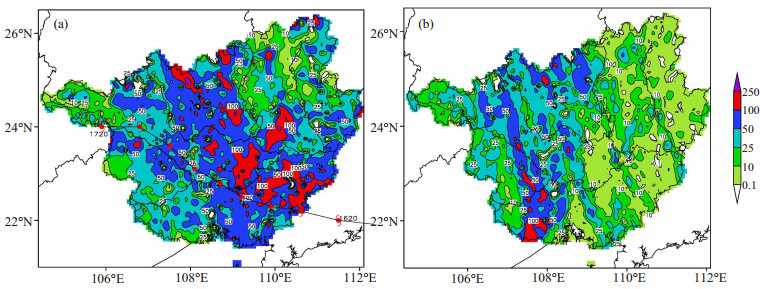CAUSE ANALYSIS ON THE STRUCTURAL CHANGE OF TYPHOON MANGKHUT DURING ITS LANDING AND THE ABNORMAL DISTRIBUTION OF HEAVY PRECIPITATION IN GUANGXI
-
摘要: 利用地面加密自动站观测资料、多普勒天气雷达及NCEP格点再分析资料,对2018年第22号台风“山竹”登陆前后环境场、动力热力场结构变化特征进行了分析,并初步探讨台风造成广西强降水分布异常的成因。(1) 200 hPa南亚高压稳定维持、西南季风与越赤道气流、西太平洋气流卷入提供水汽和能量是台风登陆后强度减弱缓慢的重要因素。(2)台风登陆移入广西过程中,其中高层θse漏斗状结构、正涡度柱状结构维持,东侧和北侧低层有深厚入流辐合上升,高层有明显出流。(3)水平风场的不对称分布导致台风东侧到北侧存在明显的风向切变和风速辐合,出现垂直螺旋度正值中心和强水汽辐合区,对应有螺旋对流回波带发展、维持,这可能是“山竹”强降水出现在台风偏北侧的重要原因。(4)云贵高原冷空气的侵入加剧了热力不稳定,加上地形抬升增幅作用,导致桂北和桂西持续强降水。(5) “山竹”降水分布与低层湿位涡负值区有较好对应,强降水主要出现在湿正压项(MPV1)负值中心附近和MPV1负值区与湿斜压项(MPV2)正值区相叠加的区域。Abstract: Based on the intensified observation data from automatic weather stations, Doppler weather radars and the reanalysis data of NCEP grid point, the characteristics of structural changes of environmental field, dynamic and thermodynamic fields before and after the landfall of the 2018 typhoon Mangkhut (1822) were analyzed, and the causes of the abnormal distribution of heavy precipitation brought by typhoon were preliminarily discussed. The results are shown as follows. (1) A stable 200 hPa South Asia High, southwest monsoon, cross-equatorial airflow and the western Pacific airflow providing water vapor and energy were the important factors for the slowing and weakening of the typhoon after its landfall. (2) During the process of typhoon landing and moving into Guangxi, the funnel-shaped structure of high-level θse and positive vorticity column structure were maintained, while deep inflow convergence rose in the lower floors on the east and north sides, and there was obvious outflow in the upper floors. (3) The asymmetrical distribution of the horizontal wind field led to obvious wind direction shear and wind speed convergence from the east to the north side of the typhoon, and the occurrence of a positive vertical spirality center and a strong water-vapor convergence zone. Correspondingly, a spiral convection echo zone developed and maintained. All of these changes may be the main reasons for the occurrence of heavy precipitation north of the typhoon. (4) The invasion of cold air from Yunnan-Guizhou plateau aggravated the thermal instability, and coupled with the increase of topographic uplift, resulted in continuous heavy precipitation in northern and western Guangxi. (5) The precipitation distribution of Mangkhut corresponded well with the negative area of the low-layer moist potential vortex (MPV), and the heavy precipitation mainly occurred near the center of the negative area of the positive pressure term (MPV1) and the area where the negative area of the MPV1 superimposed with the positive area of the moist baroclinic pressure term (MPV2).
-
-
[1] 陈玉林, 周军, 马奋华.登陆我国台风研究概述[J].气象科学, 2005, 25(3):319-329. [2] 陈伟斌, 黄荣成, 屈梅芳, 等.快速台风"海鸥"强度、路径特点及成因分析[J].中国农学通报, 2015, 31(26):200-209. [3] CHANG C P, YEH T C, CHEN J M. Effects of terrain on the surface structure of typhoons over Taiwan[J]. Mon Wea Rev, 1993, 121(3):734-752. [4] 赵玉春, 王叶红, 陈健康, 等. "莫兰蒂"台风(2016)登陆前后精细结构及其引发福建特大暴雨的模拟研究[J].暴雨灾害, 2018, 37(2):135-148. [5] 李英, 陈联寿, 雷小途. Winnie(9711)台风变性加强过程中的降水变化研究[J].大气科学, 2013, 37(3): 623-633. [6] 周芯玉, 梁建茵, 黄健, 等.台风"天鹅"、"巨爵"登陆过程风场结构特征的研究[J].热带气象学报, 2012, 28(6):809-818. [7] 叶成志, 李昀英.湘东南地形对"碧利斯"台风暴雨增幅作用的分析[J].暴雨灾害, 2011, 30(2):122-129. [8] 丁治英, 陈久康.有效位能和冷空气活动与台风暴雨增幅的研究[J].热带气象学报, 1995, 11(1):80-85. [9] 赵金彪, 韩慎友, 李佳颖.影响广西的两次台风暴雨中尺度对比分析[J].暴雨灾害, 2014, 33(2):156-162. [10] 程正泉, 陈联寿, 李英.登陆台风降水的大尺度环流诊断分析[J].气象学报, 2009, 67(5):840-850. [11] 岳彩军, 韩志惠, 顾问, 等. "海棠"台风(2005)暴雨及其非对称分布特征成因研究[J].暴雨灾害, 2017, 36(4):293-300. [12] 黄海洪, 林开平, 高安宁, 等.广西天气预报技术和方法[M].北京:气象出版社, 2012:224-227. [13] 朱乾根, 林锦瑞, 寿绍文, 等.天气学原理和方法[M].北京:气象出版社, 2007:548-550. [14] 陈联寿, 徐祥德, 罗哲贤, 等.热带气旋动力学引论[M].北京:气象出版社, 2002:11-12. [15] 蔡菁, 吴立广, 赖巧珍, 等.台风"苏拉"登陆福建后降水的非对称成因分析[J].大气科学学报, 2017, 40(6):814-822. [16] 林良勋, 梁巧倩, 黄忠.华南近海急剧加强热带气旋及其环流综合分析[J].气象, 2006, 32(2):14-18. [17] 王新, 方翔, 邱红, 等.应用AMSU-B微波资料分析0509号Matsa台风水汽场分布特征[J].气象, 2014, 35(12):30-36. [18] 姚日升, 涂小萍, 俞芳芳, 等. 1614号超强台风"莫兰蒂"在浙江沿海降水预报偏小的原因[J].热带气象学报, 2018, 34(5):637-644. [19] 岳彩军. Q矢量、螺旋度、位涡及位涡反演在台风暴雨研究中的应用进展[J].暴雨灾害, 2014, 33(3):193-201. [20] 夏大庆, 郑良杰, 董双林, 等.气象场的几种中尺度分离算子及其比较[J].大气科学, 1983, 7(3):303-311. [21] 周玲丽, 高领花, 王东法, 等.台风强暴雨的中尺度分析[J].浙江大学学报, 2008, 35(3):330-335. [22] 高守亭, 崔春光.广义湿位涡理论及其应用研究[J].暴雨灾害, 2007, 26(1):3-8. [23] 黄亿, 寿少文, 傅灵艳, 等.对一次台风暴雨的位涡与湿位涡诊断分析[J].气象, 2009, 35(1):65-73. [24] 李慧芹, 李江南, 于艳, 等.一次海南秋季台风暴雨的特征和成因分析[J].热带气象学报, 2018, 34(1):133-144. [25] 张东, 林芳妮, 何如意, 等.珠江口以西登陆热带气旋引发粤东暴雨的成因和预报着眼点分析[J].热带气象学报, 2019, 35(1): 14-24. [26] 龚俊强, 刘朝顺, 刘延安, 等.探空和飞机观测资料联合同化对台风"苏迪罗"(2015)数值模拟的影响研究[J].热带气象学报, 2019, 35(1): 99-112. [27] 钱晓蕾, 余锦华, 王晨稀.东亚高空纬向风的季节内振荡对登陆中国大陆热带气旋活动的影响[J].热带气象学报, 2018, 34(5): 705-712. [28] 陆晓婕, 董昌明, 李刚. 1951-2015年进入东海的台风频数及登陆点的变化[J].大气科学学报, 2018, 41(4): 433-440. [29] 丁治英, 黄海波, 赵向军, 等. "莫拉克"台风螺旋雨带与水平涡度的关系[J].大气科学学报, 2018, 41(4): 454-462. [30] 吴国雄, 蔡雅萍, 唐晓菁.湿位涡和倾斜涡度发展[J].气象学报, 1995, 53(4):387-405. -






 下载:
下载:









 粤公网安备 4401069904700003号
粤公网安备 4401069904700003号